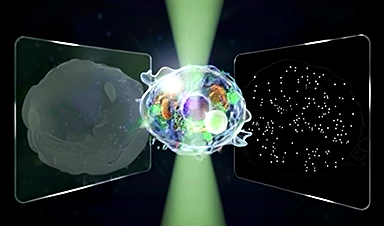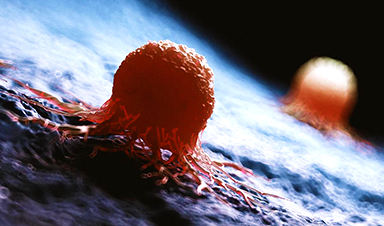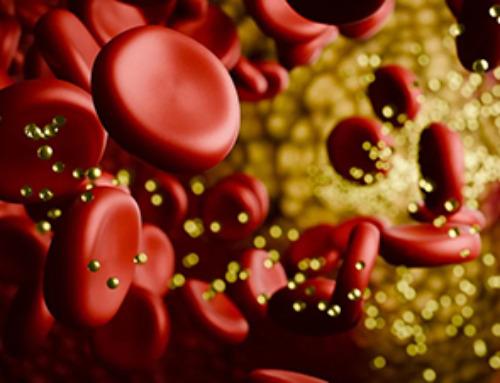The Science
Scientists have developed tiny nanocrystal particles made up of isotopes of the elements lanthanum, vanadium, and oxygen for use in treating cancer. These crystals are smaller than many microbes and can carry isotopes of elements such as actinium and radium. These isotopes undergo radioactive decay, emitting alpha particles (helium nuclei) that destroy cancer cells in the process. The individual isotopes that the nanocrystals carry are too small to see. So, the researchers used advanced computer simulations and data from experiments to understand how the isotopes are arranged inside the nanocrystals. This knowledge will help researchers design more effective radioactive nanocrystals that target and kill tumors.
The Impact
This research could revolutionize cancer therapy by enabling doctors to treat more types of cancers using an approach called targeted alpha therapy. This therapy delivers radioactive substances directly to diseased tissue, where they then decay and break DNA strands in the cancer cells. Targeted therapies have fewer side effects and cause only minimal damage to surrounding healthy cells. Previous studies have found that these therapies can be as much as 50% more effective than traditional chemotherapy, in which patients receive powerful drugs that kill cancer cells. However, alpha therapy only works for types of cancers for which researchers have found effective delivery methods. This study may lead to new imaging methods for cancer detection and diagnosis, as well as new, more effective cancer therapies.
Summary
Inorganic nanocrystals loaded with medical radioisotopes are promising tools for cancer therapy because they offer a new way to deliver cancer-killing radiation to tumors. This study focused on how two radioactive isotopes, actinium and radium, become part of these nanocrystals so they can be delivered to cancer cells. Using a combination of experimental synthesis and molecular dynamics simulations, the research team discovered that the actinium isotopes tend to form tightly packed clusters within the nanocrystals, while radium isotopes distribute more broadly across their surface.
The findings, validated in the laboratory by analyzing their chemical signatures at high resolution, help provide a blueprint for designing nanocrystals optimized for cancer therapy. These new therapies will benefit the treatment of localized tumors, such as breast, brain, and ovarian cancer, but will also have the advantage of being targetable to metastatic cancer anywhere in the body. This type of radiation treatment destroys the targeted cancer cells with minimal damage to healthy organs, resulting in fewer side effects. Understanding these therapies at the atomic level opens new pathways for tailoring them to image and treat more types of tumors.
Funding
This research was supported by the Oak Ridge National Laboratory Directed Research & Development (LDRD) program. The isotopes used in this research were supplied by the Department of Energy (DOE) Isotope Program, managed by the DOE Office of Isotope R&D and Production. The simulations used resources of the Oak Ridge Leadership Computing Facility at Oak Ridge National Laboratory and the National Energy Research Scientific Computing Center, both of which are DOE Office of Science user facilities.
News
Current Heart Health Guidelines Are Failing To Catch a Deadly Genetic Killer
New research reveals that standard screening misses most people with a common inherited cholesterol disorder. A Mayo Clinic study reports that current genetic screening guidelines overlook most people who have familial hypercholesterolemia, an inherited disorder that [...]
Scientists Identify the Evolutionary “Purpose” of Consciousness
Summary: Researchers at Ruhr University Bochum explore why consciousness evolved and why different species developed it in distinct ways. By comparing humans with birds, they show that complex awareness may arise through different neural architectures yet [...]
Novel mRNA therapy curbs antibiotic-resistant infections in preclinical lung models
Researchers at the Icahn School of Medicine at Mount Sinai and collaborators have reported early success with a novel mRNA-based therapy designed to combat antibiotic-resistant bacteria. The findings, published in Nature Biotechnology, show that in [...]
New skin-permeable polymer delivers insulin without needles
A breakthrough zwitterionic polymer slips through the skin’s toughest barriers, carrying insulin deep into tissue and normalizing blood sugar, offering patients a painless alternative to daily injections. A recent study published in the journal Nature examines [...]
Multifunctional Nanogels: A Breakthrough in Antibacterial Strategies
Antibiotic resistance is a growing concern - from human health to crop survival. A new study successfully uses nanogels to target and almost entirely inhibit the bacteria P. Aeruginosa. Recently published in Angewandte Chemie, the study [...]
Nanoflowers rejuvenate old and damaged human cells by replacing their mitochondria
Biomedical researchers at Texas A&M University may have discovered a way to stop or even reverse the decline of cellular energy production—a finding that could have revolutionary effects across medicine. Dr. Akhilesh K. Gaharwar [...]
The Stunning New Push to Protect the Invisible 99% of Life
Scientists worldwide have joined forces to build the first-ever roadmap for conserving Earth’s vast invisible majority—microbes. Their new IUCN Specialist Group reframes conservation by elevating microbial life to the same urgency as plants and [...]
Scientists Find a Way to Help the Brain Clear Alzheimer’s Plaques Naturally
Scientists have discovered that the brain may have a built-in way to fight Alzheimer’s. By activating a protein called Sox9, researchers were able to switch on star-shaped brain cells known as astrocytes and turn them into [...]
Vision can be rebooted in adults with amblyopia, study suggests
Temporarily anesthetizing the retina briefly reverts the activity of the visual system to that observed in early development and enables growth of responses to the amblyopic eye, new research shows. In the common vision [...]
Ultrasound-activated Nanoparticles Kill Liver Cancer and Activate Immune System
A new ultrasound-guided nanotherapy wipes out liver tumors while training the immune system to keep them from coming back. The study, published in Nano Today, introduces a biodegradable nanoparticle system that combines sonodynamic therapy and cell [...]
Magnetic nanoparticles that successfully navigate complex blood vessels may be ready for clinical trials
Every year, 12 million people worldwide suffer a stroke; many die or are permanently impaired. Currently, drugs are administered to dissolve the thrombus that blocks the blood vessel. These drugs spread throughout the entire [...]
Reviving Exhausted T Cells Sparks Powerful Cancer Tumor Elimination
Scientists have discovered how tumors secretly drain the energy from T cells—the immune system’s main cancer fighters—and how blocking that process can bring them back to life. The team found that cancer cells use [...]
Very low LDL-cholesterol correlates to fewer heart problems after stroke
Brigham and Women's Hospital's TIMI Study Group reports that in patients with prior ischemic stroke, very low achieved LDL-cholesterol correlated with fewer major adverse cardiovascular events and fewer recurrent strokes, without an apparent increase [...]
“Great Unified Microscope” Reveals Hidden Micro and Nano Worlds Inside Living Cells
University of Tokyo researchers have created a powerful new microscope that captures both forward- and back-scattered light at once, letting scientists see everything from large cell structures to tiny nanoscale particles in a single shot. Researchers [...]
Breakthrough Alzheimer’s Drug Has a Hidden Problem
Researchers in Japan found that although the Alzheimer’s drug lecanemab successfully removes amyloid plaques from the brain, it does not restore the brain’s waste-clearing system within the first few months of treatment. The study suggests that [...]
Concerning New Research Reveals Colon Cancer Is Skyrocketing in Adults Under 50
Colorectal cancer is striking younger adults at alarming rates, driven by lifestyle and genetic factors. Colorectal cancer (CRC) develops when abnormal cells grow uncontrollably in the colon or rectum, forming tumors that can eventually [...]





















